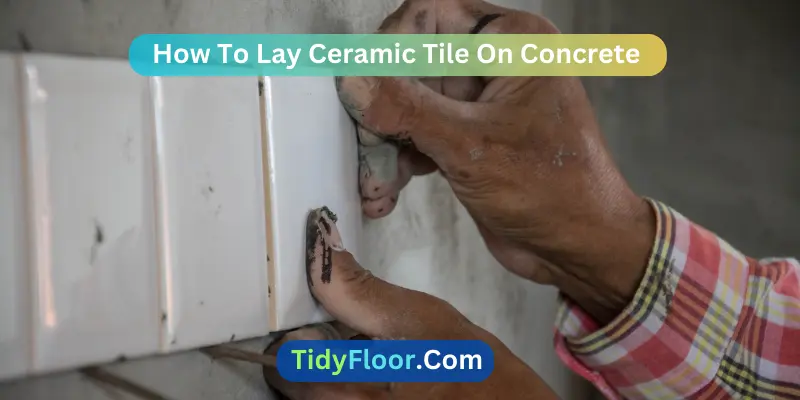Ceramic tiles are a popular choice for flooring due to their durability, aesthetics, and ease of maintenance. If you have a concrete floor in your space, laying ceramic tiles can be a fantastic way to upgrade its look and functionality. With the right tools, materials, and a little know-how, you can learn how to lay ceramic tiles on concrete surfaces.
Achieve a professional ceramic-tiled floor by preparing and leveling the concrete surface. Plan the layout, apply thin-set mortar, and carefully lay the tiles, adjusting as needed. Once set, apply grout and consider sealing for added protection and beauty.
In this step-by-step guide, we will walk you through the process of laying ceramic tiles on concrete, ensuring a professional-looking finish that will stand the test of time.
Learn to Lay Ceramic Tile on Concrete: 8 Step-by-Step Process
Laying ceramic tile on concrete is an excellent idea to redecorate your floor. If you are confused about the process, I got you. Here is a step-by-step guide to help you crack this project. Have a look.
Prepare the Surface
Before you start laying ceramic tiles, it’s crucial to prepare the concrete surface properly. Ensure that the concrete is clean, dry, and free of any debris. Sweep the floor thoroughly, and if necessary, use a vacuum cleaner to remove fine dust and dirt. Inspect the concrete for any cracks or uneven areas. Patch any holes or cracks with a suitable concrete patching compound, and level any uneven spots using a self-leveling compound.
Plan the Layout
Take the time to plan the layout of your ceramic tiles before you begin the installation. Start by finding the center of the room or the area you want to tile. Use a chalk line or a straightedge to create a grid on the floor, dividing it into quadrants or smaller sections. This will help you maintain straight lines and ensure that the tiles are evenly distributed across the space.
Apply Thinset Mortar
Thinset mortar is a specialized adhesive used to bond ceramic tiles to the concrete surface. Mix the thin set according to the manufacturer’s instructions. Using a trowel, apply a thin layer of mortar to a small section of the concrete, starting from the center and working your way outward. Only spread as much mortar as you can cover with tiles within 10-15 minutes to avoid it drying out.
Lay the Ceramic Tiles
Carefully place the ceramic tiles on top of the mortar, following the layout you planned. Press each tile firmly into the mortar to ensure proper adhesion. Use tile spacers between the tiles to maintain even gaps and ensure a professional finish. Check the level of each tile using a spirit level, adjusting as needed to keep the surface flat and even.
Cut Tiles as Necessary
As you reach the edges of the room or encounter obstacles like corners, doorways, or fixtures, you’ll likely need to cut some tiles to fit. Use a tile cutter or a wet saw to make precise cuts. Measure each tile carefully before cutting and remember to account for the width of the tile spacers.
Allow the Mortar to Set
After you’ve laid all the tiles, allow the thin-set mortar to set according to the manufacturer’s guidelines. This usually takes 24 to 48 hours. Avoid walking on the newly installed tiles during this time to prevent any shifting or misalignment.
Apply Grout
Once the mortar has fully set, it’s time to apply grout to fill the gaps between the tiles. Mix the grout following the manufacturer’s instructions. Use a rubber float to spread the grout over the tiles, pressing it into the gaps. Remove excess grout from the tile surface using a damp sponge.
Seal the Grout (Optional)
While not mandatory, sealing the grout can protect it from stains, moisture, and discoloration. Use a grout sealer following the manufacturer’s instructions. Allow the sealer to dry completely before using the tiled area.
7 Tips about How to Lay Ceramic Tile on Concrete Floor in Bathroom
Laying ceramic floor tiles on concrete in the bathroom can be a transformative and practical upgrade. To ensure a successful and long-lasting installation, consider the following tips:
- Clean and Prepare the Concrete Surface:
Thoroughly clean the bathroom floor to remove any dust, dirt, or debris. Check for cracks and uneven spots, and patch them with a suitable concrete patching compound. Use a self-leveling compound to create a smooth and level surface for tiling.
- Choose the Right Ceramic Tiles:
Select ceramic tiles that are specifically designed for bathroom use. Opt for tiles with low water absorption rates and slip-resistant properties to prevent accidents and ensure durability in wet environments.
- Use Waterproofing Membrane:
Consider applying a waterproofing membrane on the concrete surface before tiling. This adds an extra layer of protection against moisture, which is essential in bathrooms to prevent water damage and mold growth.
- Opt for Smaller Tiles in Sloped Areas:
If your bathroom has a sloped floor for proper drainage, choose smaller tiles for these areas. Smaller tiles are easier to conform to the slope and create a more seamless appearance.
- Follow a Pattern:
Whether you choose a classic brick pattern or a more intricate design, maintain consistency throughout the installation. This ensures a visually appealing and polished finish.
- Allow for Tile Expansion:
Ceramic tiles can expand and contract with temperature changes, so leave a small gap (about 1/8 inch) between the tiles and the walls or fixtures. Use caulk to fill these gaps after grouting.
- Use a High-Quality Thinset Mortar:
Invest in a premium-grade thin-set mortar suitable for bathroom use. A good mortar will ensure strong adhesion and prevent tile dislodgment, even in moist conditions.
5 Mistakes to Avoid When Laying Ceramic Tile on a Painted Concrete Floor:
Laying ceramic tile on a painted concrete floor can be challenging due to the existing paint layer, which may hinder proper tile adhesion. To ensure a successful and durable installation, avoid the following mistakes:
- Not Removing the Paint:
One of the most significant mistakes is attempting to tile directly over the painted concrete without removing the paint. Paint does not provide a suitable bonding surface for thin-set mortar, leading to poor adhesion and potential tile failure. It is essential to remove the paint entirely before proceeding with tiling.
- Ignoring Leveling Issues:
Avoid overlooking uneven spots or slopes on the concrete floor. Uneven surfaces can cause tiles to crack or become loose over time. Use a self-leveling compound to create a flat and smooth surface for tiling.
- Choosing the Wrong Thinset Mortar:
Using the wrong type of thin-set mortar is a mistake that can compromise the tile’s adhesion. Select a thin-set mortar specifically designed for use on concrete surfaces, ensuring compatibility and proper bonding.
- Neglecting Tile Spacers:
Not using tile spacers can result in uneven gaps between tiles, leading to an unprofessional appearance. Always use spacers to maintain consistent spacing and grout lines.
- Not Allowing Adequate Drying Time:
Patience is key when laying ceramic tile on painted concrete. Rushing the installation process and not allowing sufficient drying time for the mortar and grout can result in tile movement, misalignment, and premature damage.
FAQs:
Can I Lay Ceramic Tiles Directly On A Concrete Floor?
Yes, you can. However, it’s essential to prepare the concrete surface properly by cleaning it thoroughly, leveling any uneven spots, and filling in cracks. This ensures a stable and even base for the tiles, promoting long-lasting adhesion and preventing future issues.
What Type Of Thin-Set Mortar Should I Use For Laying Ceramic Tiles On Concrete?
Choose a thin-set mortar that is specifically labeled for use on concrete surfaces. Look for a product that offers good bonding properties and is suitable for both indoor and outdoor installations. Follow the manufacturer’s recommendations for mixing and application to achieve the best results.
Do I Need To Use Tile Spacers While Laying Ceramic Tiles On Concrete?
Yes, tile spacers are crucial to maintaining consistent gaps between the tiles, which ensures a professional and uniform appearance. Spacers also allow for proper grout application, preventing it from cracking and making cleaning easier in the long run.
How Do I Cut Ceramic Tiles To Fit Edges And Corners?
You can use a tile cutter or a wet saw to make precise cuts on ceramic tiles. Measure the area that needs a cut and mark the tile accordingly before cutting. Always wear safety goggles and follow the tool’s user manual for proper usage.
Should I Seal The Grout Of Ceramic Tile On Concrete After Applying It?
Sealing the grout is optional but recommended, especially in high-traffic areas or spaces prone to spills and moisture. Grout sealers help prevent staining, discoloration, and mold growth, extending the lifespan and appearance of your tiled floor.
How Long Should I Wait Before Walking On The Newly Ceramic Tiled Floor?
Allow the thin-set mortar to set for at least 24-48 hours before walking on the newly tiled floor. This waiting period ensures that the tiles have properly adhered to the concrete surface and prevents any misalignment or shifting.
Can I Install Ceramic Tiles On A Painted Concrete Floor?
It’s generally not recommended to install ceramic tiles directly on painted concrete. The paint might not provide a suitable bonding surface for the tiles, leading to adhesion issues. If you have a painted concrete floor, it’s best to remove the paint or consider alternative flooring options.
Can I Install Ceramic Tiles On An Outdoor Concrete Patio?
Yes, you can install ceramic tiles on an outdoor concrete patio. Use a weather-resistant thin-set mortar and consider sealing the grout for added protection against the elements. Ensure proper drainage and use tiles suitable for outdoor use to prevent cracking due to temperature fluctuations.
Is It Necessary To Use A Primer Before Applying Thinset Mortar To Lay Ceramic Tile on Concrete?
Using a primer on the concrete surface before applying thin-set mortar is not always mandatory, but it can enhance the adhesion and bonding of the mortar to the concrete. Primers can also help to prevent moisture from seeping through the concrete and affecting the tile installation.
Can I Install Large-Format Ceramic Tiles On Concrete?
Yes, you can install large-format ceramic tiles on concrete, but it may require more attention to ensure a flat and even surface. Back-butter the tiles (apply mortar to the back) and use a leveling system to prevent lippage between tiles. Be sure to follow the manufacturer’s recommendations for large-format tile installation.
Conclusion
Laying ceramic tiles on a concrete floor surface is a rewarding DIY project that can transform the look and functionality of any space. Follow the steps of how to lay ceramic tile on concrete outlined above and achieve a professional finish that will last for years to come.
Remember to exercise patience and attention to detail, and then, you’ll be enjoying the beauty and durability of your newly tiled floor.


